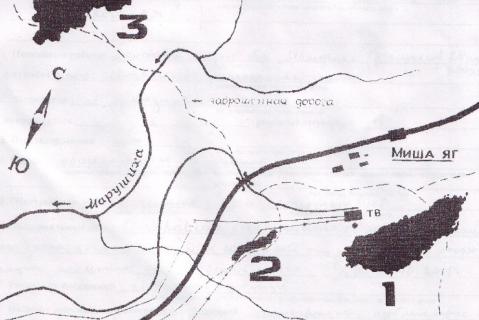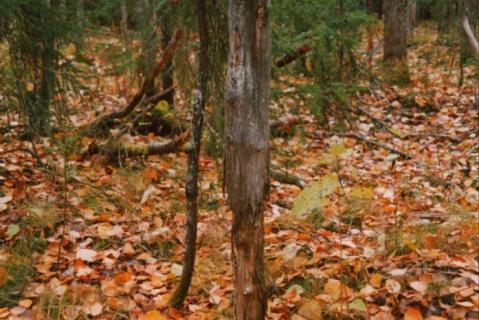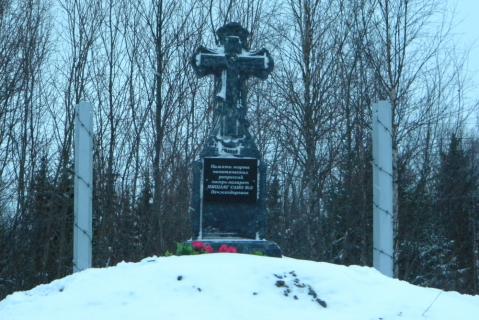Infirmary No. 2 of Sevpechlag (Pechzheldorlag) was organised at the Mishayag rail station in summer 1940. The total number of prisoners who died in the infirmary between 1940 and 1950 has not been established. Testimony by eyewitnesses, including staff from the infirmary, confirmed that there were mass burials near Mishayag.
In 1998-2003 the Pechora Memorial society and, in 1999, the town administration, carried out exploratory investigations: they studied the area, made test probes, questioned witnesses and drew up a plan of the burials. Three separate cemeteries were discovered where at various times Sevpechlag prisoners were buried: in 1940-1943, 1944-1945 and in 1946-1956. The first cemetery contained 350-400 common graves each containing 10-25 bodies. Stakes bearing the standing numbers had been partially preserved. There were also pits marked by two or more stakes; these presumably indicated repeated burials in the same pit. A compact burial of interned Polish army officers, temporarily held in Sevpechlag, was also discovered.
The second cemetery contains about 120 common graves and burial trenches which often cross one another. The third cemetery contains 7,500 individual graves and 22 large burials that may be common graves. Some of the graves from the 1950s are marked by crosses. In all three cases the boundaries of the burial area are not marked. In 2001 exploratory groups from Pechora and Syktyvkar together erected a commemorative wooden cross at the site; it has since become dilapidated and fell down. In 2012 a brigade of rail workers from Pechora put up a new cross of artificial stone.
(The map of camp burials shows three locations: [1] 1940-1943 burials; [2] 1944-1945 burials; and [3] 1946-1956 burials on the other side of the railway line. Drawn by B.B. Ivanov in 2005.)
Repentance: the Komi Republic Martyrology of the Victims of Mass Political Repression (11 vols. 1998-2016), includes biographical entries on 52,785 who were sent to the camps in Komi, of whom over 10,000 died there.
Drawing on that and other sources the Memorial online database (2025) names 225 prisoners who were held in Sevpechlag. (And see The Gulag in Northwest Russia, 1931-1960.)
| Date | Nature of ceremonies | Organiser or responsible person | Participants | Frequency |
|---|---|---|---|---|
|
nk
|
commemorative services
|
nk
|
members of exploratory groups
|
Annual event 1998-2003; thereafter from time to time
|
| State of burials | Area | Boundaries |
|---|---|---|
|
Subsidence over burials, stakes with numbers, grave crosses
|
cemeteries: No. 1, 42 hectares; No. 2, 10 hectares; and No. 3, hectares
|
not delineated
|
[ original texts and hyperlinks ]
N.A. Morozov, The Gulag in the Komi region, 1929-1956, Syktyvkar, 1997
T.G. Afanasyeva (ed), Looking into the past, a collection of local history articles, Pechora, 2009
*
“Mishayag settlement. Cemetery of Sevpechlag infirmary No 2”, The Virtual Museum of the Gulag [retrieved, 26 May 2022; no longer accessible, August 2025]
Reply from Pechora urban municipal administration (No 01-14-6229 of 7 July 2014) to a formal enquiry by RIC Memorial (St Petersburg)



